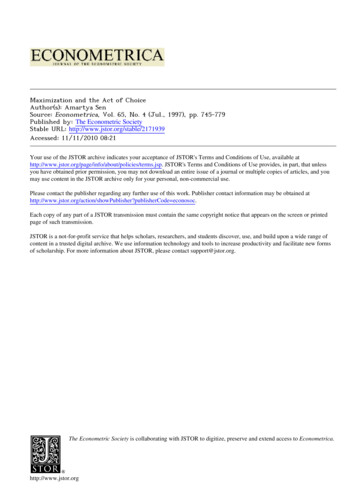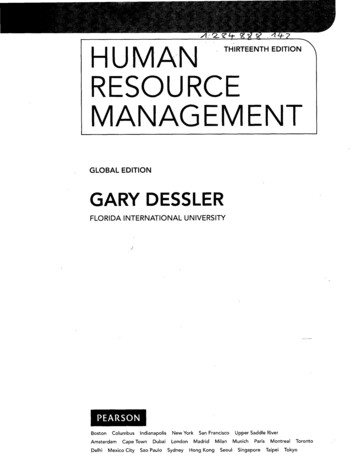
Transcription
Maximization and the Act of ChoiceAuthor(s): Amartya SenSource: Econometrica, Vol. 65, No. 4 (Jul., 1997), pp. 745-779Published by: The Econometric SocietyStable URL: http://www.jstor.org/stable/2171939Accessed: 11/11/2010 08:21Your use of the JSTOR archive indicates your acceptance of JSTOR's Terms and Conditions of Use, available rms.jsp. JSTOR's Terms and Conditions of Use provides, in part, that unlessyou have obtained prior permission, you may not download an entire issue of a journal or multiple copies of articles, and youmay use content in the JSTOR archive only for your personal, non-commercial use.Please contact the publisher regarding any further use of this work. Publisher contact information may be obtained herCode econosoc.Each copy of any part of a JSTOR transmission must contain the same copyright notice that appears on the screen or printedpage of such transmission.JSTOR is a not-for-profit service that helps scholars, researchers, and students discover, use, and build upon a wide range ofcontent in a trusted digital archive. We use information technology and tools to increase productivity and facilitate new formsof scholarship. For more information about JSTOR, please contact support@jstor.org.The Econometric Society is collaborating with JSTOR to digitize, preserve and extend access to Econometrica.http://www.jstor.org
Econometrica, Vol. 65, No. 4 (July, 1997), 745-779MAXIMIZATION AND THE ACT OF CHOICEBY AMARTYA SENThe act of choosing can have particular relevance in maximizing behavior for at leasttwo distinct reasons: (1) process significance (preferences may be sensitive to the choiceprocess, including the identity of the chooser), and (2) decisional inescapability (choicesmay have to be made whether or not the judgemental process has been completed). Thegeneral approach of maximizing behavior can-appropriately formulated-accommodateboth concerns, but the regularities of choice behavior assumed in standard models ofrational choice will need significant modification. These differences have considerablerelevance in studies of economic, social, and political behavior.KEYWORDS:Choice act, games and common knowledge of norms, incomplete preference ranking, maximizing behavior, rational choice, satisficing, axiomatic choice theory.1. THE ACT OF CHOICEIN 1638, WHENPIERRE DE FERMATsent to Rene Descartesa communicationonextremal values (pointing in particular to the vanishing first derivative), theanalytical discipline of maximization was definitively established.2 Fermat's"principle of least time" in optics was a fine minimization exercise (andcorrespondingly, one of maximization). It was not, however, a case of maximizingbehavior, since no volitional choice is involved (we presume) in the use of theminimal-time path by light. In physics and the natural sciences, maximizationtypically occurs without a deliberate "maximizer." This applies generally to theearly uses of maximization or minimization, including those in geometry, goingback all the way to "the shortest arc" studied by Greek mathematicians, andother exercises of maximization and minimization considered by the "greatgeometers" such as Apollonius of Perga.The formulation of maximizing behavior in economics has often paralleled themodelling of maximization in physics and related disciplines. But maximizingbehavior differs from nonvolitional maximization because of the fundamentalrelevance of the choice act, which has to be placed in a central position inanalyzing maximizing behavior. A person's preferences over comprehensive outcomes (including the choice process) have to be distinguished from the conditional preferences over culmination outcomes given the acts of choice. The1Text of the Frisch Memorial Lecture given at the World Econometric Congress in Tokyo, on 24August 1995. I am indebted for research support to the National Science Foundation, and forhelpful discussions and comments to Kenneth Arrow, Kaushik Basu, Eric Maskin, and KotaroSuzumura, and also to Sudhir Anand, Nick Baigent, Fabrizio Barca, Andrea Brandolini, AbhijitBanerjee, Wulf Gaertner, Frank Hahn, David Kreps, Isaac Levi, James Mirrlees, Prasanta Pattanaik,Debraj Ray, Emma Rothschild, Agnar Sandmo, Luigi Spaventa, Tony Shorrocks, Ignazio Visco, andto the anonymous referees of this journal.2 Fermat's manuscript was circulating in Paris for a few years before it was sent to Descartes, whoincidentally was not particularly impressed with it.745
746AMARTYA SENresponsibility associated with choice can sway our ranking of the narrowly-defined outcomes (such as commodity vectors possessed), and choice functions andpreference relations may be parametrically influenced by specific features of theact of choice (including the identity of the chooser, the menu over which choiceis being made, and the relation of the particular act to behavioral social normsthat constrain particular social actions). All these call for substantial analyticalattention in formulating the theory of choice behavior.3Also from a practical point of view, differences made by comprehensiueanalysis of outcomes can have very extensive relevance to problems of economic,political, and social behavior whenever the act of choice has significance.Illustrations can be found in problems of labor relations, industrial productivity,business ethics, voting behavior, environment sensitivity, and other fields.Second, in addition to the significance of the process of choice in what ischosen, the importance of the act of choice also lies in its inescapability orurgency.A chooser, who may have to balance conflicting considerations to arriveat a reflected judgement, may not, in many cases, be able to converge on acomplete ordering when the point of decision comes.4 If there is no escape fromchoosing, a choice decision will have to be made even with incompleteness inranking.The characterization of maximizingbehavior as optimization, common in muchof economic analysis, can run into serious problems in these cases, since no bestalternative may have been identified for choice. In fact, however, optimization isquite unnecessary for "maximization," which only requires choosing an alternative that is not judged to be worse than any other. This not only corresponds tothe commonsense understanding of maximization (viz. not rejecting an alternative that would be better to have than the one chosen), it is also how "maximality" is formally defined in the foundational set-theoretic literature (see, forexample, Bourbaki (1939, 1968), Debreu (1959, Chapter 1)).In Sections 2 and 3, I shall consider the reasoning behind including the choiceact in comprehensive analysis of decisions, and the connection between choosingand responsibility. Section 3 deals with the analytical implications of thisbroadening in terms of "chooser dependence" and "menu dependence" ofchoices. Section 4 is concerned with the use of norms as well as strategies inrational decisions and games. Section 5 deals with the comparisons and contrasts3This paper is concerned with choice behavior, rather than with normative choice theory.However, in so far as choice norms influence actual choice behavior, they enter this investigation.On the connection between the two exercises, see Sen (1987).4 Incompleteness can arise from limited information, or from "unresolved" value conflicts (seeSen (1970a, b), Williams (1973), Levi (1986), Putnam (1996)). Levi (1986) takes the latter as thestarting point of his far-reaching analysis of "hard choices." See also Blackorby (1975), Fine (1975),Basu (1980, 1983), Levi (1980), Putnam (1996), Walsh (1996).
THE ACT OF CHOICE747between optimizing and maximizing choice functions, and the possibility ofmoving from one to the other. The subject matter of Section 6 is the relationbetween incorporating concerns about choice acts in the form of self-imposedchoice constraints, and incorporating them within the preference relation itself.There is a concluding section. The proofs of some formal propositions havebeen relegated to the Appendix.2. DIRECT INTEREST VERSUS INSTRUMENTAL EXPLANATIONSAn example may help to illustrate the role of "comprehensive" description ofchoice processes and outcomes, in particular the "chooser dependence" ofpreference. You arrive at a garden party, and can readily identify the mostcomfortable chair. You would be delighted if an imperious host were to assignyou to that chair. However, if the matter is left to your own choice, you mayrefuse to rush to it. You select a "less preferred" chair. Are you still amaximizer? Quite possibly you are, since your preference ranking for choicebehavior may well be defined over "comprehensive outcomes," including choiceprocesses (in particular, who does the choosing) as well as the outcomes atculmination (the distribution of chairs).5To take another example, you may prefer mangoes to apples, but refuse topick the last mango from a fruit basket, and yet be very pleased if someone elsewere to "force" that last mango on you. In these choices, there is no tension atall with the general approach of maximizing behavior, but to accommodatepreferences of this kind, the choice act has to be internalized within the system.This can require reformulation of behavioral axioms for "rational choice" usedin economic and political theory (to be explored in Sections 3-6).The influence of the choice act on preferences, and in particular the dependence of preference on the identity of the chooser, can go with rather differentmotivations and may have several alternatiue explanations. The comprehensivedescriptions may be relevant in quite different ways and for quite distinctreasons.(i) Reputation and indirect effects: The person may expect to profit in thefuture from having the reputation of being a generally considerate person, andnot a vigilant "chair-grabber."5A common reaction to this type of chooser dependence (judging from seminar experience) is tothink that the "problem" arises because of a mistaken attempt to define this person's preference interms of the chair on which she herself gets to sit, and not over the full "vector" of chair allocations(involving others as well). But this is not the source of the variability here. The person may be veryhappy with a full vector of chair assignments that allocates the most comfortable chair to her, if thatvector were to be brought about by someone else's choice, but not if it had to be secured throughher own choice.
748AMARTYA SEN(ii) Social commitment and moral imperatives: She may not think it morally"right" to grab the most comfortable chair, cutting others out, and such "moralsentiments" could be explicitly followed or only implicitly obeyed.6(iii) Direct welfare effects: The person's well-being may be affected directly bythe process of choice (for example, by what people think of her-she may notenjoy the looks she gets as she makes a dash for the great chair), and thisrequires that the reflective utility function (and the person's conception of herself-interest) be defined not just over culmination outcomes (such as finalcommodity vectors, as in standard consumer theory), but inter alia also overchoice processes and their effects.(iv) Conventional rule following: She may be simply following an establishedrule of "proper behavior" (as the on-going norm), rather than being influencedby direct welfare effects, or by reputation effects, or even by any self-consciousethics.The process of choice has rather different roles in these distinct cases, andthey may, in fact, occur in various mixed forms.7 The first line of explanation("reputation and indirect effects") is most in harmony with the establishedconventions of standard neoclassical economics. It does not require any basicdeparture from the ultimate concentration on culmination outcomes (and fromrational choice guided only by self-interest). Instrumental analysis links immediate concern with the choice act with the underlying pursuit of preferredculmination outcomes (see Kreps and Wilson (1982)).In contrast with the first case, in the other three cases, the choice act isdirectly relevant, not just for its indirect effects. However, alternative explanations are possible about how this direct interest comes about-what underlyingforces cause it to occur. The recent work on evolutionary game theory hasthrown much light on how conventional rule following-explanation (iv) in theabove list-may emerge from evolutionary selection.8 Even though ultimately noindividual may be directly concerned with the nature of the choice act, concernwith the nature of the choice act may be instrumentally important in social rulesof behavior that survive. This type of reasoning can be contrasted with behav6Both Immanuel Kant (1788) and Adam Smith (1790) emphasized the importance of "moralsentiments" and their significance in rational choice. Adam Smith also discussed extensively howvarious moral values (including "generosity" and "public spirit") can alter our choice behavior, eventhough self-interest may be adequately explanatory in the special case of explaining mutuallyprofitable exchange (such as the trade between the consumer, on the one hand, and the butcher, thebrewer and the baker, on the other, in the often-quoted passage in The Wealth of Nations (Smith(1776)). In a common interpretation of Smith (see, for example, Stigler (1981)), Smith's generalclaims about behavioral diversities are largely ignored, by concentrating exclusively on his particularpoint about the profitability of exchange, thereby radically distorting Smith's choice theory (I havetried to discuss this issue in Sen (1987)).7See Sen (1987), Sacco and Zamagni (1993), Zamagni (1993, 1995), Walsh (1996).8 Different types of linkage between behavioral rules and strategic rationality have been exploredin this rapidly expanding literature; see Axelrod (1984), Kreps, Milgrom, Roberts, and Wilson (1982),Fudenberg and Maskin (1986, 1990), Fudenberg and Tirole (1992), Binmore (1994), Weibull (1995),among other contributions.
THE ACT OF CHOICE749ioral rules being deliberately chosen by an individual through an ethical examination of how one "should" act (thereby combining explanations (2) and (4)).Consciously reflective-ratherthan evolutionarily selected-useof ethicalrule-following was most famously explored by Immanuel Kant (1788).9 Thatapproach has been pursued in different forms in modern ethical writings as well,varying from Rawls' (1971) characterization of "comprehensive" goals andHarsanyi's (1976) analysis of ethical preference and social behavior, to thesociological exploration of the complex values that influence people's conduct.10I would make four brief comments on these two alternative lines of explanation. First, they need not be just "alternatives." Even if we deliberately choosebehavioral norms on ethical (or social) grounds, their long-run survival canscarcely be completely independent of their impact on each other and of theevolutionary processes that must come into play. On the other side, in studyingevolutionary processes, there is no need to confine attention only to preferencesthat ultimately relate exclusively to culmination outcomes. Evolutionary studiesof rules when people also attach intrinsic-not just instrumental-value to actsand conduct can be important to understand society.1"Second, evolutionary processes may not only influence the rules of conductthat we may consciously follow, but also our psychological preferences about theactions involved. The literature on endogeneity of preference can be fruitfullylinked with evolutionary theories.12 The same can be said about the survival ofethical norms as well. Paying reflective ethical attention to behavior neithernullifies, nor is nullified by, the importance of evolutionary forces.13Third, even if it were the case that-"ultimately"-everythingwere determined by "basic" preferences exclusively over culmination outcomes, it wouldstill be interesting and important to see how the derived preferences ("nonbasic"but functionally important) actually work in relation to the choice act. Theanalytical and mathematical aspects of these choice functions would still deserveexamination. Thus, the analysis pursued in this paper can have interest atdifferent levels of investigation-instrumental as well as basic.9Kant founded his deontological ethics on "rationality," but his interpretation of rationalitydeparted from the conscious pursuit exclusively of self-interest. Because of the narrowing of theconcept of rationality in parts of modem economics (which tends to classify as "irrational" anybehavior that is not-directly or indirectly-justifiable in terms of the person's own self-interest),Kant's idea of reflective rationality has become rather difficult for some to stomach. It has also ledto the demand, in Binmore's (1994) words, for the "DeKanting" of ethics, which he applies, withagreeable (if somewhat confusing) cheer, even to "DeKanting Rawls" (pp. 7-86).10 For a variety of perspectives on broader influences, see Nagel (1970), Sen (1973a, b), Scitovsky(1986), Frank (1988), Anderson (1993), Baigent (1994), Lewin (1996), Walsh (1996); also thecollections in Hahn and Hollis (1979), Elster (1986), Mansbridge (1990), and Zamagni (1995). Onbehavioral analysis linked with Rawlsian theory, see also Scanlon (1982) and Laden (1991).11Thiswould apply to many cases of economic, political, and social behavior empiricallyinvestigated recently (see Sections 3-5).12 In an important research initiative, led jointly by Herb Gintis and Paul Romer (sponsored bythe MacArthur Foundation), this is one of the central areas of current investigation.13See Sen (1987), Sacco and Zamagni (1993), and Zamagni (1995).
750AMARTYA SENFourth, I shall also argue that sometimes even the understanding of gamesand strategies can be enhanced by allowing broader formulations of preferencesand of rules of behavior, and of the common knowledge of norms (a simpleexample is considered in Section 4). In following such games, it is important totake note of the influence of the nature of the choice act on strategies, nomatter what view we take about the "ultimate" origin of that influence.3. RESPONSIBILITY, CHOOSER DEPENDENCE AND MENU DEPENDENCEThe direct importance of the choice act typically relates to the idea ofresponsibility. Our attitudes towards responsibility may or may not be mediatedthrough our personal well-being.14 We may enjoy exercising responsibility; ornot enjoy it at all but still feel the duty to act responsibly; or-as in thegarden-chair example-we may find the responsibility of choice a constraint anda burden.To take a very different type of case from the garden-chair example, the act ofvoting in an election may be very important for a person because of thesignificance of political participation. This has to be distinguished from whatevermay be added by a person's vote to the likelihood of the preferred candidate'schances of winning (the addition could be negligible when the electorate islarge). It is possible that the voter may enjoy participation, or that she may actunder some "deontic" obligation to participate whether or not she enjoys it. Solong as she attaches importance to the participatory act of voting, the analysis ofthe rationality of voting must take note of that concern, whether that concernarises from anticipated enjoyment, or from a sense of duty (or of course, both).In either case, it can be argued that the well-known literature on "why dorational people vote" may have tended to neglect an important concern underlying voting behavior, viz. the choice act of voting. There may, in fact, be no puzzlewhatever as to why people vote even when the likelihood of influencing thevoting outcome is minuscule.Similarly, in understanding "work ethics," it may be inadequate to confineattention to the simple fact that work may be a strain, or that work can be apleasurable activity, or even that a worker may take a familial interest in theconsequential fortunes of the firm (apparently an important part of Japanese14While the concentration of this paper is not on the substantive content of our objectives, I havediscussed elsewhere (Sen (1973b, 1977b)) the limitations imposed by taking an overly narrow view ofhuman motivation (see also Frey (1992)). I shall not pursue that debate further in this essay. There isa different debate-one on "consequentialism"-with which the subject of this essay also indirectlyrelates. The idea of judging all choice variables by their-and only by their-consequences is called"consequentialism." Consequentialism in a fairly restrictive form is, in fact, simply taken for grantedin much of traditional economics. But its basic soundness has been disputed in many philosophicalwritings (see, for example, Williams (1973) and Nozick (1974)). This issue will not be further pursuedhere, but I have elsewhere defended "consequential evaluation" in a broad form: (i) by includingactions performed within the relevant consequences, and (ii) by admitting "positional" perspectivesin evaluating consequences (Sen (1982b, 1983)). The use of consequential evaluation in this paper isin this broad form. See also Hammond (1985, 1986), Binmore (1994), Moulin (1995), Walsh (1996).
THE ACT OF CHOICE751work ethics).15 The importance of participation itself may be closely related towork ethics, and different interpretations of participation may contribute to theexplanation of varying work ethics in different countries and cultures. Theimportance of participation can be quite crucial also in the operation of"environmental values," which is one of the reasons why the market analogy isoften quite deceptive in assessing "existence values" of what people try activelyto preserve.16Sometimes the connection between preference and choice acts may be rathersubtle and complex, and turn on the exact nature of the actions involved. Forexample, in the context of work ethics, there may be a substantial differencebetween (i) actively choosing to "shirk" work obligations, and (ii) passivelycomplying with a general atmosphere of work laxity. The latter may happenmuch more readily than the former, and the exact nature of the choice act canbe very important in this difference. In fact, "herd behavior" not only hasepistemic aspects of learning from others' choices (or being deluded by them, onwhich see Banerjee (1992)), but can also be linked with the possibility thatjoining a "herd" makes the choice act less assertive and perspicuous. Thediminished use of forceful and aggressive volition in (ii) may make it muchharder to resist than (i). Such differences may be of great importance inpractice, even though they may be difficult to formalize completely.Some types of influences of choice acts are more easy to formalize thanothers, and these include: (i) chooser dependence, and (ii) menu dependence.Consider the preference relation Pi of person i as being conditional on thechooser j and the set S from which the choice is being made: PiifS. Chooserdependence and menu dependence relate to the parametric variability of Piwith j and S respectively.17Consider chooser dependence first-already introduced in the motivationaldiscussion. To return to one of the earlier examples, in choosing betweenalternative allocations of fruits from a set S (ml, al, a2} of one mango and twoapples for two persons i and k, person i who prefers mangoes may like theallocation ml that gives the mango to him (and an apple to k), over theallocation a' whereby i gets an apple (say, a'), so long as the choice is made bysomeone else j:(3.1)15mlP sa1On different interpretations of Japanese work ethics, see Morishima (1982, 1995), Dore (1987),Ikegami (1995). For related issues in economic analyses, taking extensive note of institutional andbehavioral features, see Aoki (1989) and Suzumura (1995).16 A "social choice" approach (going beyond the market analogy underlying procedures of"contingent valuation") can be helpful in incorporating the value of participation (see Sen (1995b))in environment-sensitive choices of actions.17The variations here relate to the "positionality" of the observer (see Sen (1982b) on theinfluence of positionality), and in particular on the "position" of being the chooser, over a givenmenu.1973
752AMARTYA SENand yet prefer to go for the opposite if he himself has to do the choosing:(3.2)alp iSml.Along with this chooser dependence, there is a related feature of menudependence, particularly in the case of self-choice. If the set of available optionsis expanded from S to T containing two mangoes and two apples, person ihimself may have no difficulty in choosing a mango, since that still leaves thenext person with a choice over the two fruits. On the other hand, menu-dependence of preference is precisely what is ruled out by such assumptions as theweak axiom of revealed preference (WARP) proposed by Paul Samuelson(1938), not to mention Houthakker's (1950) strong axiom of revealed preference(SARP). Indeed, even weaker conditions than WARP, such as Properties a andr (basic contraction and expansion consistency), which are necessary and sufficient for binariness of choice functions over finite sets (see Sen (1971)), muchused in general choice theory as well as social choice theory, are violated bysuch choices.18How are these basic conditions of intermenu consistency violated by theconcerns we are examining? Consider the same example again. While an applea' is what person i may pick if he is choosing from S (as given by (3.2)), he maysensibly go for one of the mangoes (say, min) from the enlarged set T {ml, nm2, al, a2}:(3.3)mlpij al .The combination of (3.2) and (3.3) violates Property a as well as WARP andSARP, and it can be easily shown with further examples that this type of menudependence can lead to the violation of the other standard consistency conditions.19 Menu dependence-when true-may be quite a momentous characteristic of choice functions.2018WARP demands that if an alternative x is picked from some set S, and y (contained in S) isrejected, then y must not be chosen and x rejected, from some other set T to which they bothbelong. Property a demands that if some x is chosen from a set T and is contained in a subset S ofT, then x must be chosen from the subset S. Property T demands that if x is chosen from each of aclass of sets, then it must be chosen from their union. Analyses of these and related choiceconditions can be found in Hansson (1968a, 1968b), Sen (1970a, 1971, 1982a), Herzberger (1973),Plott (1973), Parks (1976), Aizerman and Malishevski (1981), Suzumura (1976, 1983), Deb (1983),Moulin (1985), Sugden (1985), Levi (1986), Kreps (1988), Heap et al. (1992), Aizerman and Aleskerov(1995), Baigent (1995).19 For example, to check that Property T will be violated, we can note that apple al may bepicked over mango ml when the choice is over {mi, al, a2}, and also apple al over mango m2 in thechoice over (m2, al, a2}, and yet the person could, consistently with his priorities, choose mango mlor mi2, and not an apple, when the choice is over the foursome (m1, mi2, al, a2}, the union of the twoprevious sets.20 My experience in presenting this paper in seminars has alerted me to the possibility that somereaders will seek explanation of the alleged "inconsistency" in the influence of "framing" (in linewith Kahneman and Tversky's (1984) important findings). But these two problems are quite distinct.The influence of "framing" arises when essentially the same decision is presented in different ways,whereas what we are considering here is a real variation of the decision problem, when a change ofthe menu from which a choice is to be made makes a material difference. There is, in fact, noinconsistency here, only menu dependence of preference rankings (see Sen (1993)).
THE ACT OF CHOICE753The above discussion concentrates only on one kind of reason for menudependent preferences (related to the direct relevance of the choice act), butthere can be other reasons for such dependence (on this see Sen (1993)). Oneconnection may come from the value we place on our autonomy and freedom ofdecisions.21 We may value not merely the alternative we eventually choose, butalso the set over which we can exercise choice. In valuing the "autonomy" of aperson, it is not adequate to be concerned only with whether she receives whatshe would choose if she had the opportunity to choose; it is also important thatshe actually gets to choose herself.22Also, when our knowledge is limited, the menu may have epistemic importance, and we may "learn" what is going on from the menu we face. Forexample, if invited to tea (t) by an acquaintance you might accept the invitationrather than going home (0), that is, pick t from the choice over {t, O}, and yetturn the invitation down if the acquaintance, whom you do not know very well,offers you a wider menu of either having tea with him, or some heroin andcocaine (h), that is, you may pick 0, rejecting t, from the larger set {t, h, 0}. Theexpansion of the menu offered by this acquaintance may tell you somethingabout the kind of person he is, and this could affect your decision even to havetea with him (see Sen (1993)).A different type of example of epistemic use of menus can be found in usingone's own menu to judge the opportunities that others would have to undertakesimilar behavior. In explaining "corrupt" behavior in business and politics inItaly, a frequent excuse given has been: "I was not alone in doing it." A personmay resist seizing a unique opportunity of breaking an implicit moral code, andyet be willing enough to break that code if there are many such opportunities,on the indirect reasoning that the departures may be expected to become more"usual."23 Similarly, a unique opportunity of "crossing the picket line" may berejected by some
between optimizing and maximizing choice functions, and the possibility of moving from one to the other. The subject matter of Section 6 is the relation between incorporating concerns about choice acts in the form of self-imposed choice constraints, and










